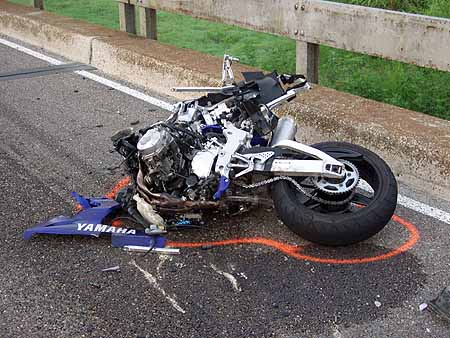
Few would argue that motorcycle accident injuries have the potential to be more severe than other accident injuries that occur on roadways. Though motorcycle accidents can happen under any condition or circumstance, a common misconception held by many is that motorcycle accidents are often a result of negligence by motorcyclists themselves. Yet, the reality is the opposite, as more motorcycle accidents than not are caused by drivers of other vehicles.
In large part, this is due to a motorcycle’s relatively smaller size and lower visibility on the highway. One study by NHTSA, the National Highway Traffic Safety Administration, reported that most motorcycle accidents—three-quarters of them—involve another vehicle whose driver failed to observe or detect the motorcycle in traffic. Add to this a greater risk to life and limb for motorcyclists when on the road. Per vehicle miles traveled, a motorcyclist is 28 times more likely to be involved in a fatal crash and four times more likely to be injured than occupants in passenger vehicles.
Motorcycle accidents often occur in ordinary circumstances. The Maine DOT’s recent five-year study on motorcycle accidents (2016 to 2020) confirms this. The study found that, of the 2,797 motorcycle accidents that occurred, 80% happened in broad daylight, 2,478 of the accidents were in clear conditions, 2,588 were on dry roads, and over 90% of motorcyclists’ physical condition was normal and unimpaired in any way (only 5% were under the influence, i.e., 147). Of these accidents, 119 (4.25%) were fatal, and another 2,254 were injury crashes (80.59%). Of those crashes, 542 were suspected serious, and another 1,712 resulted in other types of injuries.
To help prevent motorcycle accidents, drivers should always remain alert for motorcycles on the road. Remembering that motorcycles share the road with you can reduce the chance of an accident and help save lives and serious injuries.
Most Common Types of Motorcycle Accident Injuries
The most common types of injuries from motorcycle accidents happen from the bottom up.
Lower Limbs
Injuries to the legs and lower extremities are motorcyclists’ most common accident injuries. In the event of a crash, a combination of a rider’s legs being exposed on impact and the sheer weight of a motorcycle toppling on or over a rider often leads to injury. Riders can be subjected to broken bones, torn ligaments, and road rash, particularly calves, ankles, knees, and feet. Though such injuries are, thankfully, non-fatal, they are exceptionally painful and can result in surgeries, months of recovery and rehab, long-term disability, and even a permanent limp.
Upper Extremities
The next most common motorcycle accident injuries are to the upper body, which occurs when a motorcyclist is launched from the bike during an accident. As the rider is airborne,they would instinctively use their hands and arms to protect themselves from the fall. Common injuries include shoulder dislocations, torn rotator cuffs, broken arms and elbows, and the possibility of nerve damage.
Chest and Abdomen
The blunt force trauma of the impact can also damage the chest and abdomen area. Not only are broken ribs, lacerated or punctured kidneys, lungs, or spleen common injuries in motorcycle accidents, but internal bleeding or possibly infection, if undetected, can result. Lungs are vulnerable to bruising and possibly collapsing, which would require ventilation if not immediate surgical intervention.
Head and Brain Trauma
Injuries to the head, face, and neck are undoubtedly some of the more serious that motorcyclists suffer in accidents. Most obviously, permanent physical damage and even death are a consequence of such injuries. At risk for head injuries are concussions, brain damage, skull fractures, brain hemorrhaging and swelling, and paralysis. With head injuries come the loss of motor skills, coordination, memory, anxiety, depression, or speech and vision problems. Broken jawbones, cheekbones, noses, and smashed teeth can lead to reconstructive surgery and permanent scarring. Neck injuries range from whiplash and damaged tendons to strained ligaments, nerves, and pulled muscles.
Spinal Injuries
Lastly are spinal injuries. Depending on the circumstances of the accident, in addition to broken bones, an impact may leave a motorcyclist with partial or complete paralysis. It may be temporary or permanent and generally includes an extended hospital stay and lengthy recovery period to get back to “normal.” Spinal injuries can also lead to chronic pain, respiratory issues, and sexual dysfunction.
If You’ve Been Injured, We Can Help You
Motorcycle accidents can result in severe or fatal injuries. The legal team at Hardy, Wolf & Downing wish to remind drivers of cars and trucks always to be alert for the presence of motorcycles on the road any time of year, but particularly during the spring and summer months when the weather conditions are perfect for riding.
If you have been injured in a motorcycle accident, Hardy, Wolf & Downing will work hard for you to receive the full compensation you deserve for your injuries. For more information or to receive a free evaluation of your case, contact the motorcycle injury attorneys at Hardy, Wolf & Downing.

